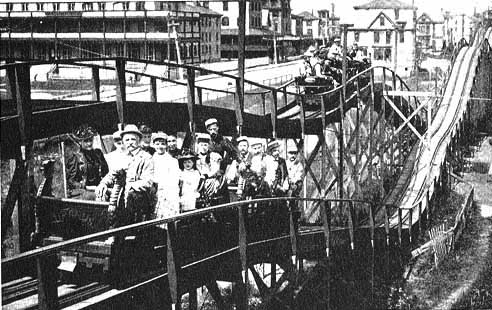But when you deconstruct the concept of a theme park to its roots: A bunch of engineers (you know, the guys who make factories and spaceships and automobiles) designing complex (and expensive) machines for the amusement of the world. It’s manufactured fun at its most pure; which would be weird, if they weren’t so damn fun.
With the Olympics wrapping up in Sochi last weekend, it’s fair to say that Russia has been on the mind the past two weeks. I’ve watched more than my fair share of elite athletes compete in sports you don’t see on ESPN every day. Take luge, for instance. Men and women strap themselves to sleds and hurl themselves down icy mountains at incredible speeds for...fun? Are they crazy?
Maybe not.
Perhaps their thrill-seeking desires are just more finely tuned (and extreme) than the ones we exhibit when we strap ourselves into the newest Bolliger and Mabillard creation. After all, the modern day roller coaster was born on sheets of ice in the very country where athletes like Noelle Pikus-Pace competed this past week.
Russian ice slides are the patient zero of the roller coaster epidemic. While luge did not become an Olympic sport until 1964, ice slides came into popularity in the 17th century; perhaps the sport of luge descended from this early form of amusement?
Regardless of their origin, these slides struck a nerve amongst the upper and lower classes alike. Of course even a country known for the cold like Russia couldn’t sustain a wooden ramp covered in ice year round -- not over a hundred years before refrigeration was invented. This wasn’t the only problem, of course. While sliding down a sheet of ice while sitting on a block of ice may sound fun, it’s not exactly the safest way to spend one’s leisure time.
From the perspective of a business, making an attraction that appeals to more guests means more money. Walt Disney World isn’t the most successful theme park in the world just because of Mickey Mouse. It’s a theme park where people of all ages can find something of value — which means people of all ages will hand over their money for it. Capitalism!

Next came an ice slide without ice. In France, large wooden slides were built and wheels were attached to sleds to make carts. The problem? No track. Sliding down an icy hill with no track is one thing, but down a wooden ramp in wagon? Well, let’s just say OSHA wouldn’t be impressed. The solution came with “Les Montagues Russes a Bellevilles” in 1817. Tracks were constructed that locked wheels in place, creating the first true roller coaster.
From there came The Scenic Railway in the 1850s. What was originally designed as a transportation system at large mines became an amusement attraction on slow days. LaMarcus Adna Thompson then took that concept and created The Switchback Railway, which opened at Coney Island in 1884. From there, roller coasters grew more elaborate, culminating with the first golden age of roller coasters in the 1920s.

That whole “great depression” thing or whatever really killed the mood in the 1930s, but thanks to World War II (yay wartime economy!) things got back into gear in the 1950s. Then came the invention of tubular steel track which led to the second golden age of roller coasters, which was spearheaded by Arrow Dynamics.

In 1984 it all came full circle as the Olympics inspired theme parks. Six Flags opened two bobsled roller coasters: One in Six Flags Great Adventure and the other at Magic Mountain. Both were named after the 1984 Sarajevo games and both were moved from their current parks just in time for the Calgary games in 1988 (a coincidence, I’m sure). Of course, both of those roller coasters are in better shape now than their namesake.
Six Flags didn’t rush to brand a “Sochi Slides” concept to celebrate the most recent winter games, but the Olympics, Russia and roller coasters will be permanently intertwined.
Tweet
This article has been archived and is no longer accepting comments.